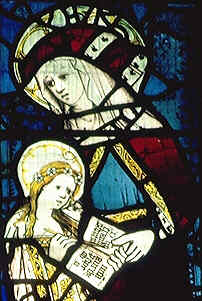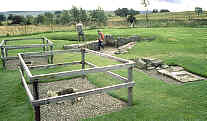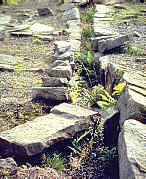



If you are looking at this page without frames, there is more information about medieval writing to be found by going to the home page (framed) or the site map (no frames).
| The Concept of Literacy | ||||
| Whenever politicians, newspaper editors or educational theorists are feeling a bit bored, they conspire to produce an article under a screamer headline that literacy in our society has taken a nosedive. It usually revolves around an assertion that a certain proportion of a particular age group, usually still in school, does not have adequate literacy to function in our society. But the whole lot of them together cannot produce a mutually satisfactory measure of what constitutes adequate literacy. The concept is as slippery as an eel, even within our own society where we are supposed to know what our own needs are, and as things function at the moment those needs are very great. |  |
|||
| St Anne teaches the Virgin to read in a 15th century stained glass window in the parish church of All Saints, North Street, York. | ||||
| Arguments about the level of literacy in the middle ages, or any other exotic port, can get extremely tangled around the concept of what the term literacy actually implies. It is possible to be adequately literate for a position in society, even an elevated one, without being a speed reader of today’s standards and possibly without being able to write at all. | ||||
 |
We tend to see reading literacy and writing literacy as inseparable concepts. That is how we have been taught from a very early age. Before we have even much of a spoken vocabulary we are sitting down heroically trying to remember the difference between b and d with such mnemonics as “bat and ball”, “drum and soldier”. My left handed son informed me that it was all very well, but the stupid teacher didn’t know which way the soldier with the drum was going. We combine verbal concepts, spatial concepts, visual recognition and motor skills into a complex mental map before we are even properly toilet trained. They didn’t do that in the middle ages. | |||
| A schoolboy finds a handy use for a book on a misericord carving in Boston parish church, Lincolnshire. | ||||
| Having been bludgeoned into early literacy, we then fail to recognise a culture based on oral testimony and feats of memory. We consider a basic test of literacy as being whether a person can read without moving their lips. In a culture where reading was a co-operative activity where one person read aloud to others, this criterion has no relevance. In a culture which remembered much, reading a familiar work might consist of a large percentage of memory, jogged along by periodic reminders from the text. | ||||
| Writing was a different matter altogether. There were professionals who would write for you; priests, lay scriveners, notaries. From Charlemagne to Margery Kempe there were people who could probably read, to some degree, and who valued the written word, but who employed others to write for them. | ||||
| The society of ancient Rome, from which our written heritage derives, was essentially literate. Written documentation was essential to its forms of government and administration. It had platoons of authors. While it is always difficult to know how far these skills spread down through society, we do know that they wrote graffiti on the walls of Pompeii and put up signs saying CAVE CANEM (Beware of the dog) on their gates. A large find of wooden writing tablets at Vindolanda on Hadrian’s Wall showed that soldiers wrote letters home asking their Mums to send them new sandals and underwear and sending cheerio calls to their old mates in the regiment. (Bowman 1983 or see the web site Vindolanda Tablets Online) |  |
|||
| Some excavated segments of Vindolanda, on Hadrian's Wall, where soldiers sat in the freezing fog and dreamed of past times, good company and warm underwear. | ||||
 |
||||
| The barbarian invaders from the north were illiterate. Some adopted the Roman mode of literacy pretty quickly. Theoderic the Ostrogoth, invader of Rome itself, had fancy Bibles made in the Gothic language. It was a way of being Roman. In England the Anglo-Saxons did it their own way and conducted their affairs through sworn and witnessed oral testimony. It took a long time for this to be entirely replaced. The way in which literacy developed and was utilised by certain segments of society is a fascinating story in itself. | ||||
|
If you are looking at this page without frames, there is more information about medieval writing to be found by going to the home page (framed) or the site map (no frames). |
||||